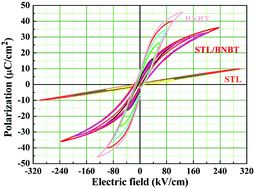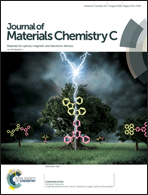Enhanced energy storage properties of a novel lead-free ceramic with a multilayer structure†
Abstract
A (SrTiO3 + Li2CO3)/(0.94Bi0.54Na0.46TiO3 − 0.06BaTiO3) (STL/BNBT) lead-free ceramic with a multilayer structure was shaped via the tape-casting and subsequent lamination technique, and sintered using the conventional solid state sintering method. The dielectric constant of the ceramic is larger than that of pure STL or BNBT and reveals excellent frequency-stability, and the dielectric loss is smaller than 0.15 for the STL/BNBT multilayer ceramic at 1 kHz–1 MHz and room temperature. Meanwhile, dielectric measurement results reveal that the STL/BNBT multilayer ceramic possesses relaxor behavior. In addition, the STL/BNBT multilayer ceramic possesses large maximum polarization (Pmax) and low remnant polarization (Pr). An optimal energy storage density (W) of 3.55 J cm−3 and a recoverable energy storage density (Wrec) of 2.41 J cm−3 can be obtained under 237 kV cm−1 for the STL/BNBT multilayer ceramic. Numerical simulations based on the finite element analysis method present the breakdown process vividly and agree well with the experimental results. Moreover, the energy storage properties of STL/BNBT multilayer ceramic exhibit excellent frequency stability and temperature stability. The STL/BNBT multilayer structure significantly enhances the electric breakdown strength (Eb) and energy storage properties of lead-free ceramics for pulsed power system applications.



 Please wait while we load your content...
Please wait while we load your content...